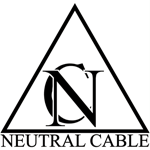I cavi di potenza sono i cavi che collegano l’amplificatore ai diffusori.
Come per i cavi di segnale i parametri elettrici che ne determinano il risultato sono la capacità, l’induttanza e la resistenza. In particolare la capacità non deve essere troppo elevata ed associata a lunghezze di oltre 3m pena il rischio di autoscillazione dell’ampli o peggio il suo danneggiamento. In linea di massima un cavo a bassa capacità, come le classiche piattine inglesi Naim o Exposure, aiuteranno molto gli ampli di bassa potenza fornendo un suono corposo e “libero” ma con dei limiti nella ricostruzione dell’immagine e del dettaglio. Al contrario, sempre in linea di massima, un cavo ad alta capacità fornirà dettaglio e trasparenza, ma un suono piuttosto aggrappato ai diffusori, poco generoso.
Capacità ed induttanza sono parametri inversamente proporzionali ed è per questo che le sonorità dei cavi a bassa capacità e quelli ad alta capacità sono agli antipodi. Neutral Cable per le sue linee di cavi di potenza ha scelto di adottare una capacità media o medio bassa a secondo dei modelli, ottenendo cavi di potenza che hanno un suono generoso e musicale, ma al contempo dettagliato e dinamico.
I cavi Neutral Cable sono terminati tutti con bananine in rame ad alta purezza Furutech FT 212, ma su richiesta possono essere terminati anche con forcelle ad alta purezza Furutech FT 211.
Un altro parametro di cui occorre tener conto è la lunghezza del cavo. Più aumenta la lunghezza del cavo e maggiore sarà la sua resistenza, cioè lunghezza e resistenza sono caratteri inversamente proporzionali. Consigliamo, anche contro i ns. interessi quindi di mettere il tavolino hi fi al centro tra i 2 diffusori avendo cavi di lunghezza standard di 2,5m/3m piuttosto che il tavolino in angolo con 5/6m di cavo di potenza per raggiungere i diffusori.
Speaker Cables: The Ideal Choice for Connecting Speakers to Amplifiers
Speaker cables are essential components in a hi-fi audio system, as they connect the amplifier to the speakers. Their quality can significantly influence the sound performance of your setup. When discussing speaker cables, it’s crucial to consider various electrical parameters, including capacitance, inductance, and resistance. These factors determine not only the quality of the audio signal transmitted but also the overall listening experience.
Importance of Capacitance in Speaker Cables
The capacitance of a cable should not be too high, especially for lengths exceeding 3 meters. Excessive capacitance can lead to issues such as amplifier oscillation or, in the worst cases, permanent damage to the equipment. Generally, a low-capacitance cable, such as classic English flat cables from Naim or Exposure, is well-suited for low-power amplifiers, providing a rich and “free” sound. However, such cables may exhibit limitations in soundstage reconstruction and detail.
Conversely, high-capacitance cables tend to offer greater detail and transparency, but the sound can become more “tied” to the speakers, resulting in a less generous audio experience. Therefore, the choice of the right cable depends on the type of amplifier and speakers in use.
The Relationship Between Capacitance and Inductance
It’s important to note that capacitance and inductance are inversely proportional parameters. This means that low-capacitance cables tend to produce warmer, richer sound characteristics, while high-capacitance cables deliver more detailed and transparent sound, but with less engagement. For this reason, Neutral Cable has opted for speaker cables with medium or medium-low capacitance, depending on the model. This choice enables the creation of speaker cables that provide a generous, musical sound without compromising detail and dynamics.
Termination and Material Quality
All Neutral Cable speaker cables are terminated with high-purity copper Furutech FT 212 banana plugs. Upon request, they can also be terminated with high-purity Furutech FT 211 forks. The quality of the connectors is crucial for ensuring lossless signal transmission and maintaining audio integrity, thus enhancing the overall listening experience.
Cable Length and Resistance
Another crucial factor to consider is the length of the speaker cable. As the length of the cable increases, its resistance also rises. In other words, length and resistance are inversely proportional. It is advisable to position the hi-fi table in the center between the two speakers, using standard-length cables of 2.5 m or 3 m. This not only improves sound quality but also helps avoid using excessively long cables (5-6 m), which could compromise performance.
Choosing the Right Speaker Cable
When selecting a speaker cable, it is essential to consider several factors:
- Compatibility with the system: Ensure that the cable is suitable for your amplifier and speakers. The right combination will guarantee better sound.
- High-quality materials: Choose cables made from high-quality materials, such as high-purity copper, to ensure optimal signal transmission.
- Appropriate dimensions: Opt for cables of adequate length to avoid resistance issues and maintain high-quality sound.
- Quality connectors: Investing in cables with high-quality connectors, such as those from Furutech, can make a significant difference in the final sound quality.
Conclusion
In summary, speaker cables are a fundamental element for any quality audio system. Choosing the right cables, taking into account capacitance, inductance, length, and materials used, can significantly impact your system’s sound performance. Neutral Cable offers customized solutions to meet the needs of every music enthusiast, ensuring rich, detailed, and dynamic sound. Investing in high-quality speaker cables is a crucial decision for anyone looking to experience engaging and authentic listening.





